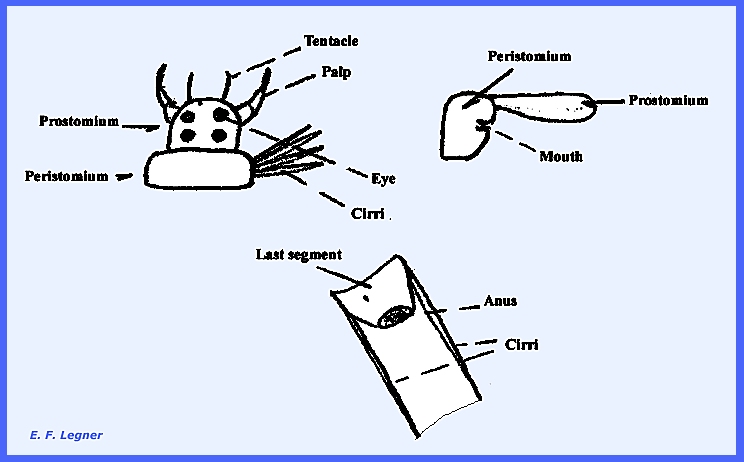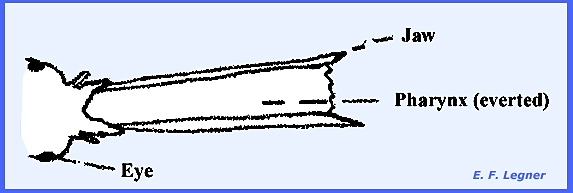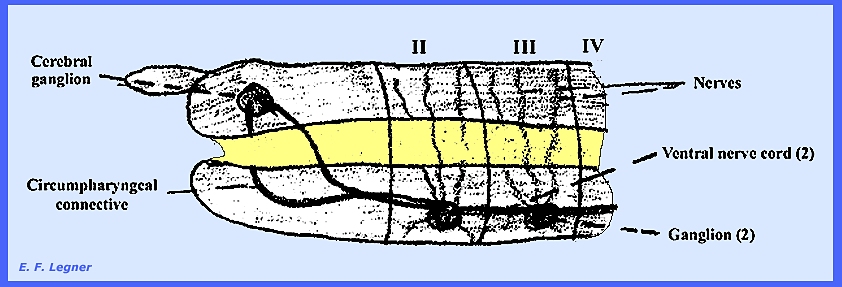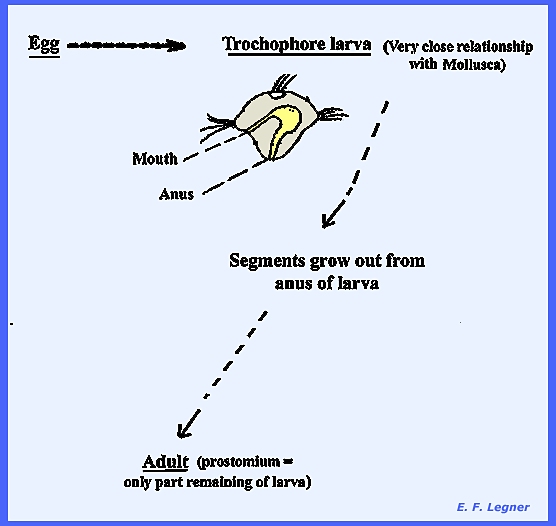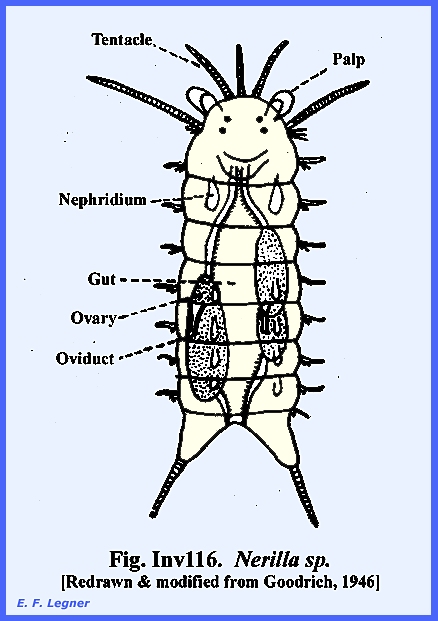File:
<annelida.htm> <Index to Invertebrates> <Bibliography> <Glossary> Site Description <Navigate to Home>
|
Invertebrate
Zoology Kingdom: Animalia, Phylum: Annelida (Contact)
CLICK on underlined
file names and included illustrations to enlarge: The Annelida include the two-segmented
worms, earthworms,
and ringed worms. Arrangement of the various groups on
Annelida is in a constant state of flux as specialists continue to disagree
on where to place the members. As of
July 2010 the classification show here tends to have the majority of
adherents. They are the first phylum with
segmentation. Their body is divided
into a linear series of metameres.
They have bilateral symmetry; a true coelom and one pair of nephridia
are located in most segments. Nephridia reach
their highest point of development in this group. They possess a non-chitinous cuticle but they have chitinous
setae. The nervous system consists of a
dorsal brain, a ventral, double and solid nerve cord and a ganglion in every
segment Circulation is via a well-developed
blood system, which is usually closed, and a dorsal blood vessel or heart. Most species occur in the marine
environment, but some are terrestrial and others are found in
freshwater. Their size varies from
microscopic to over four meters in length. Marine forms have trochophore
larvae and thus there is a common ancestry with the Mollusca. ------------------------------------ The Class Polychaeta, meaning "many
bristles" includes those species that possess tufts of chitinous setae on
every segment of the body. All
characteristics of the phylum are present.
There is a well-developed head with sensory structures, such as
tentacles, palps and eyes. There are
lateral outgrowths called parapodia,
which occur on every segment and are equipped with setae. Transient gonads appear
only during the breeding season and occur in many segments of the body. There are no definite openings for gametes
to exit the body, so they escape via temporary openings or by rupturing of
the body wall. Most are marine
organisms, but some do occur in fresh and brackish water. An example Genus is Nereis (=
Neanthes). The species occur on coastal shores where
they live in tubes in mud or sand, which are lined by a mucous secretion. Body
Plan.
-- The species are long and cylindrical with a series of segments that are
more or less identical except for the posterior and anterior segments, which
have homomous metamerism. There is an iridescent cuticle, which is
caused by fine striations. The mouth
is anterior and the anus posterior.
The head consists of two parts: (1)
prostomium
that bears palps,
tentacles and eyes and (2) peristomium that
bears cirri and a mouth. The
posterior segment bears the anus and anal cirri. Body
Wall. -- There is a cuticle, which is permeated
with small holes through which mucous pores.
There is a glandular epidermis, circular muscles, feathery
longitudinal muscles, a peritoneum and a coelom. The coelom is divided into partitions, or septa, which
correspond to each segment. Pores
through the septa allow for inter-communication. Food
& Digestion. -- All species are
primarily predaceous, their food consisting of small crustaceans and other
worms. The food is captured by means
of an eversible pharynx
that bears powerful
jaws on the everted tip. There is a short esophagus and a
long intestine where digestion and absorption occurs. The wall of the intestine is well
developed with circular and longitudinal muscles and it is covered by a
peritoneum. Circulation.
-- The dorsal blood vessel
is contractile having peristaltic
contractions. It pumps the blood anteriorly. Paired
branches lead to each segment, and the blood moves forward. The ventral
blood vessel
collects blood from the
segments and carries it posteriorly.
It is usually not contractile. Commissures connect the two
vessels at the anterior and posterior ends.
The blood is found in capillaries or
vessels, but there are no sinuses.
The blood is dissolved in the plasma or haemoglobin. Respiration.
-- The whole body surface functions in respiration, but the greatest
respiration occurs in the parapodia.
The oxygen carrying capacity of the blood is high due to the
haemoglobin. Excretion.
-- One pair of nephridia occurs in all segments except the last few and the
first segments. The nephridium is
composed of a funnel, a tubule and nephridiopore. The funnel portion lies in one segment while the tubule and
pore lie in the adjacent segment. The
funnel is called the nephrostome. The tubule is well supplied with blood
vessels and both secretions and excretions pass through its walls. Movement.
-- There is a worm-like movement, which includes crawling, burrowing and
swimming. Nereis is primarily burrowing. Sense Organs.
-- The eyes include a lens, pupil and retina. Tentacles, palps, cirri, ventral portions of the parapodia and
the general body surface all are sensory. Nervous System.
-- Included here are a dorsal brain or cerebral ganglia, a ventral nerve cord,
ganglia in each segment and circumpharyngeal
connectives. Reproduction.
-- Nereis has transient gonads,
which are found in posterior parts of the body and seem to develop from the
peritoneum. There are no genital
ducts and the gametes are shed through temporary openings in the body
wall. Fertilization occurs in the
open water; however, males are attracted to the female while she is shedding
the eggs. The mating season is predictable,
being regulated according to phases of the moon. In the South Seas a worm, Palolo living
in coral burrows has posterior segments bearing gametes that break off and
indulge in mating only. The sequence of development is
shown in the following diagram Inv112: Asexual reproduction occurs which
involves budding. Economic
Importance. -- The Polychaeta
have no direct economic importance but they may serve as food for other
marine animals. ------------------------------------ Please
see following plates for Example Structures of the Polychaeta: Plate 54 =
Phylum: Annelida -- Class: Oligochaeta & Polychaeta: Lumbricus terrestris & Nereis
sp. Plate 69 =
Phylum: Annelida -- Class: Polychaeta: Segmental structure of Nereis showing segmental organs Plate 70 =
Phylum: Annelida -- Class: Polychaeta: Blood system of Pomatocerus Plate 71 = Phylum:
Annelida -- Class: Polychaeta: Coelomic circulation in Aphrodite Plate 72 =
Phylum: Annelida -- Class: Polychaeta: Filter feeding in Sabella Plate 73 =
Phylum: Annelida -- Class: Polychaeta: Nephridia & coelomoducts in
polychaetes Plate 74 =
Phylum: Annelida -- Class: Polychaeta: Nephridia in tubicolous polychaetes ------------------------------------ The Class Clitellata
includes Subclasses
Oligochaeta, Branchiobdellida and Hirudinea. The SubClass Oligochaeta, meaning
"few-bristled" have members with no well developed head. There are few bristles such as in the
earthworm where there are only four pairs per segment. Permanent gonads are located in definite
segments of the body. These are
hermaphroditic animals with no parapodia.
They occur primarily in freshwater and terrestrial environments, but
there are a few marine species. An example species is the
earthworm Lumbricus
terrestris. Body
Plan. -- The head is absent and there are no
parapodia. Setae are few in number,
with four pairs on each segment: two
ventrally and two ventro-laterally. A
swollen structure, the Clitellum is
present on the epidermis, which secretes a cocoon
in which the eggs are deposited.
Permanent genital openings occur for both sexes on the same
animal. The male opening is on
segment 15 and the female opening on segment 14. There are also dorsal pores on each segment that open from the
coelom to the outside of the body, but their function is not completely
understood. The last segment bears
the anus. Body
Wall. -- This is similar to the Polychaeta
except that the epidermis is very glandular and secretes mucous from
one-celled gland cells. The
longitudinal muscle bundles are distinct, however. Food
& Digestion. -- Food is obtained
from organic debris and the earth generally.
The pharynx is highly muscular and sucks food into the body. The esophagus is equipped with calciferous
glands, which neutralize
highly acid soils. An enlarged part
of the esophagus is the crop, which is
thin-walled and used for storage. A
thick-walled gizzard
is present that grinds
up food material. There is an invagination of the
intestine called the typhlosole, which
increases the surface area for absorption and secretion of enzymes. Circulation.
-- This is similar to Nereis except
that aortic loops
that encircle the
esophagus are present, which connect dorsal and ventral vessels. These loops are not the main pumping
organs but they are the principal mechanism to maintain blood pressure. The blood is made up of haemoglobin in
plasma. Respiration.
-- There is diffusion through the entire body surface, and there are many
capillaries in the epidermis.
Hemoglobin in the blood also carries oxygen. Excretion.
-- Paired nephridia are present. Chloragogue
tissue
accumulates
wastes. This is situated around the
intestine and typhlosole. Pieces of
the cells break off into the coelom and are picked up by nephridia. Locomotion.
-- Contractions of the body and setae that enhance traction allow the animal
to move about. Nervous
System. -- There are no
visible sense organs, but sensory cells occur that are light and taste
sensitive. Light sensitive areas are
situated in the anterior and posterior regions, which taste or
gustatory-sensitive areas are anterior. Reproduction.
-- Lumbricus is hermaphroditic and
only cross-fertilization occurs where each animal acts each sex during
copulation. The organs involved in
reproduction are the testes, of which there are two pair on segments 10 and
11. Seminal vesicles enclose the
testes and are used for storage and maturation of sperm. There are three pair joined at the
base. The vas deferens joins to two
pores. Male genital pores are on the
15th segment. One pair of ovaries
occur on the 13th segment under the intestine. The oviduct is connected to a pore on segment 14. Two seminal receptacles are on each of
segments 9 and 10. They open to the
outside by separate ducts and are used to store sperm received from male
organs of other animals. A clitellum
secretes mucous to hold worms together during copulation and also to secrete
a cocoon on segments 33-37. During copulation each worm
exchanges sperm to the seminal receptacle of the other. The clitellum secretes a cocoon around the
body. As the worm moves the cocoon
begins to move interiorly, picking up eggs as it passes over the female pore
and sperm and albumen as it passes over the seminal receptacle pore. The ends of the cocoon are then closed. Fertilization is external in the
cocoon. Development in the cocoon
involves no larval stage and a miniature worms hatch out. Asexual reproduction occurs which
involves budding. Economic
Importance. -- Earthworms are
valuable in their ability to aerate and fertilize soils. ------------------------------------ Please see following plates for
Example Structures of the Oligochaeta: Plate 53 =
Phylum: Annelida: Oligochaeta: Lumbricus
terrestris -- Dorsal View of Earthworm Plate 54 =
Phylum: Annelida -- Class: Oligochaeta & Polychaeta: Lumbricus terrestris & Nereis
sp. Plate 75 =
Phylum: Annelida -- Various heads found in Oligochaeta ------------------------------------ Comparison of Polychaeta with Oligochaeta In Polychaeta
a parapodium is present, the sexes are separate and gonads are
temporary. There is a head with
distinct sensory organs. There is a
free-swimming trochophore larva and all members occur in marine environments. Asexual reproduction is by budding. Haemoglobin is present. Some species have a green pigment with
iron called chlorocruorin. The Oligochaeta
do not have a parapodium. They are
hermaphroditic with permanent gonads.
The head is indistinct and there are no sense organs. Development is direct with no larval
stage. They inhabit terrestrial and
freshwater environments. There is
also a budding asexual stage.
Haemoglobin is present and Chloragogue tissue accumulates wastes. ------------------------------------ The SubClass Branchiobdella has only about 150 species of small
animals that are mainly parasites or commensals on crayfish), ------------------------------------ The SubClass Hirudinia
includes the leeches,
which are blood-sucking parasites of other animals. They are primarily freshwater animals, but terrestrial and
marine members exist. Their
characteristics bear a closer resemblance to Oligochaeta than Polychaeta. Body
Plan. -- There is a higher degree of flattening
than in the other members of the Annelida.
They possess conspicuous suckers on
both ends of the body, and there are a definite number of segments for each
species in the adult form. Segments
are subdivided into "annuli"
which are a secondary segmentation.
A cluster of simple eyes is situated on each side of the head (Inv114). Food
& Digestion. -- There are some
predatory species but most are parasitic on other organisms. They have three chitinous jaws that are
able to make incisions. Salivary
glands prevent coagulation of a host's blood. The pharynx sucks the host's blood into the body. The crop is very large with many lateral
pouches that store food. There is a
stomach, intestine, rectum and anus. Circulation.
-- There is a modified circulation where the blood goes into sinuses, which
are remnants of the true coelom.
These are lined with gelatinous tissue called botryoidal
tissue. This reduced and modified coelom differs
from all the other Annelida. Part of
the coelom is used as a haemocoel, and is thus thought of as a partially open
system. Respiration.
-- Capillaries are present in the epidermis and oxygen diffuses through the
skin. Excretion.
-- Nephridia perform excretion and bladders are
present for storage. Motion
& Locomotion. -- There is swimming
and a measuring worm movement that is facilitated by suckers. Nervous System. -- Sense
organs are the eyes and papillae on the anterior end. Nerves are present as in other Annelida. Reproduction.
-- This is similar to the Oligochaeta as they are hermaphroditic and
cross-fertilization occurs. The
clitellum is not visible externally as there is no swelling. Development is direct. In some species the sperm are deposited on
the body and they make their way through the body wall and into the cavity. Economic
Importance. -- Hirudinia have
been implicated in the transmission of some diseases. Their attachment to swimmers in lakes
causes fright and minor irritation. ------------------------------------ The Class Myzostomida includes a group of small parasitic worms
that live on crinoids, a type of echinoderm. They were first discovered in
1827. Some species, as Myzostoma cirriferum, move around on the
host. Myzostoma glabrum
remains motionless with its pharynx inserted in the mouth
of the crinoid. Myzostoma deformator produces a gall on the arm
of the host, one joint of the pinnule growing around the worm enclosing it in
a cyst while Myzostoma pulvinar lives in the alimentary canal
of a species of Antedon A typical animal has a flattened rounded
shape, with a thin edge drawn out into tiny radiating hairs or cirri. The
dorsal surface is smooth, with five pairs of parapodia on the bottom. Parapodia are armed with hooked setae, by
means of which the worm adheres to its host. Past the parapodia are four
pairs of organs, called suckers. These organs are believed to be sensory and are comparable to the lateral sense
organs of Capitellids. The mouth and cloacal opening are usually at opposite
ends of the bottom surface. The former leads to a protrusible pharynx, from
which the oesophagus opens into an intestinal chamber with branching lateral
diverticula. There is no observed vascular system. The nervous system
consists of a circumoesophageal nerve, with a slightly differentiated brain,
joining below a large mass of ganglia. The dorsoventral and the parapodial
muscles are developed, but the coelom is reduced mostly to branched spaces in
which the genitalia mature. Full-grown myzostomids are
hermaphroditic. Their internal organs consist of a branched sac that opens to
the exterior or each side of the animal. Paired ovaries discharge eggs into a
median chamber with side branches, referred to as the uterus, from which the
ripe ova are discharged by a mediar dorsal pore into the end of the rectum. ------------------------------------ The Class Arachianelida (Haplodrili) is sometimes considered
as an order in the Polychaeta. It is
a small group of marine animals that do resemble the Polychaeta. However, they are most primitive in some
ways and quite advanced in others.
Segmentation is indistinct externally, but very obvious
internally. Parapodia and setae are
absent. Nervous tissue is in contact
with the epidermis and there is only one brain ganglion. Nephridia are present. These animals are hermaphroditic
or dioecious. There is a trochophore
in the developmental cycle. They have
no known direct economic importance, but like the Polychaeta they may serve
as food for other animals (See illustrations
Inv115,
Inv116, and Inv117). ------------------------------------ ============== |
